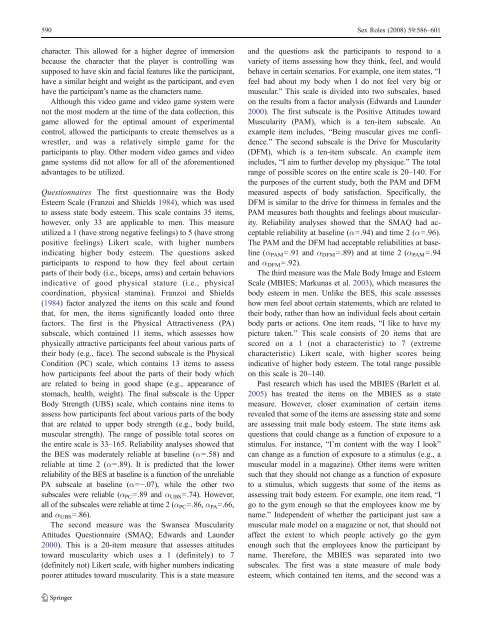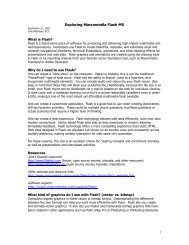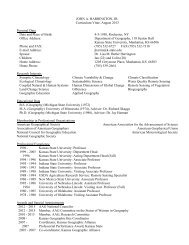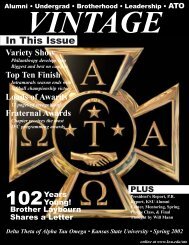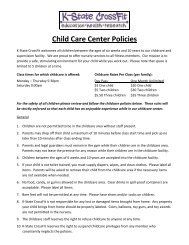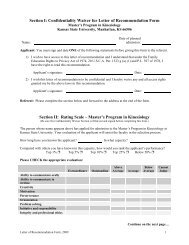The Impact of Body Emphasizing Video Games on Body Image ...
The Impact of Body Emphasizing Video Games on Body Image ...
The Impact of Body Emphasizing Video Games on Body Image ...
- No tags were found...
You also want an ePaper? Increase the reach of your titles
YUMPU automatically turns print PDFs into web optimized ePapers that Google loves.
590 Sex Roles (2008) 59:586–601character. This allowed for a higher degree <str<strong>on</strong>g>of</str<strong>on</strong>g> immersi<strong>on</strong>because the character that the player is c<strong>on</strong>trolling wassupposed to have skin and facial features like the participant,have a similar height and weight as the participant, and evenhave the participant’s name as the characters name.Although this video game and video game system werenot the most modern at the time <str<strong>on</strong>g>of</str<strong>on</strong>g> the data collecti<strong>on</strong>, thisgame allowed for the optimal amount <str<strong>on</strong>g>of</str<strong>on</strong>g> experimentalc<strong>on</strong>trol, allowed the participants to create themselves as awrestler, and was a relatively simple game for theparticipants to play. Other modern video games and videogame systems did not allow for all <str<strong>on</strong>g>of</str<strong>on</strong>g> the aforementi<strong>on</strong>edadvantages to be utilized.Questi<strong>on</strong>naires <str<strong>on</strong>g>The</str<strong>on</strong>g> first questi<strong>on</strong>naire was the <str<strong>on</strong>g>Body</str<strong>on</strong>g>Esteem Scale (Franzoi and Shields 1984), which was usedto assess state body esteem. This scale c<strong>on</strong>tains 35 items,however, <strong>on</strong>ly 33 are applicable to men. This measureutilized a 1 (have str<strong>on</strong>g negative feelings) to 5 (have str<strong>on</strong>gpositive feelings) Likert scale, with higher numbersindicating higher body esteem. <str<strong>on</strong>g>The</str<strong>on</strong>g> questi<strong>on</strong>s askedparticipants to resp<strong>on</strong>d to how they feel about certainparts <str<strong>on</strong>g>of</str<strong>on</strong>g> their body (i.e., biceps, arms) and certain behaviorsindicative <str<strong>on</strong>g>of</str<strong>on</strong>g> good physical stature (i.e., physicalcoordinati<strong>on</strong>, physical stamina). Franzoi and Shields(1984) factor analyzed the items <strong>on</strong> this scale and foundthat, for men, the items significantly loaded <strong>on</strong>to threefactors. <str<strong>on</strong>g>The</str<strong>on</strong>g> first is the Physical Attractiveness (PA)subscale, which c<strong>on</strong>tained 11 items, which assesses howphysically attractive participants feel about various parts <str<strong>on</strong>g>of</str<strong>on</strong>g>their body (e.g., face). <str<strong>on</strong>g>The</str<strong>on</strong>g> sec<strong>on</strong>d subscale is the PhysicalC<strong>on</strong>diti<strong>on</strong> (PC) scale, which c<strong>on</strong>tains 13 items to assesshow participants feel about the parts <str<strong>on</strong>g>of</str<strong>on</strong>g> their body whichare related to being in good shape (e.g., appearance <str<strong>on</strong>g>of</str<strong>on</strong>g>stomach, health, weight). <str<strong>on</strong>g>The</str<strong>on</strong>g> final subscale is the Upper<str<strong>on</strong>g>Body</str<strong>on</strong>g> Strength (UBS) scale, which c<strong>on</strong>tains nine items toassess how participants feel about various parts <str<strong>on</strong>g>of</str<strong>on</strong>g> the bodythat are related to upper body strength (e.g., body build,muscular strength). <str<strong>on</strong>g>The</str<strong>on</strong>g> range <str<strong>on</strong>g>of</str<strong>on</strong>g> possible total scores <strong>on</strong>the entire scale is 33–165. Reliability analyses showed thatthe BES was moderately reliable at baseline (α=.58) andreliable at time 2 (α=.89). It is predicted that the lowerreliability <str<strong>on</strong>g>of</str<strong>on</strong>g> the BES at baseline is a functi<strong>on</strong> <str<strong>on</strong>g>of</str<strong>on</strong>g> the unreliablePA subscale at baseline (α=−.07), while the other twosubscales were reliable (α PC =.89 and α UBS =.74). However,all <str<strong>on</strong>g>of</str<strong>on</strong>g> the subscales were reliable at time 2 (α PC =.86, α PA =.66,and α UBS =.86).<str<strong>on</strong>g>The</str<strong>on</strong>g> sec<strong>on</strong>d measure was the Swansea MuscularityAttitudes Questi<strong>on</strong>naire (SMAQ; Edwards and Launder2000). This is a 20-item measure that assesses attitudestoward muscularity which uses a 1 (definitely) to 7(definitely not) Likert scale, with higher numbers indicatingpoorer attitudes toward muscularity. This is a state measureand the questi<strong>on</strong>s ask the participants to resp<strong>on</strong>d to avariety <str<strong>on</strong>g>of</str<strong>on</strong>g> items assessing how they think, feel, and wouldbehave in certain scenarios. For example, <strong>on</strong>e item states, “Ifeel bad about my body when I do not feel very big ormuscular.” This scale is divided into two subscales, based<strong>on</strong> the results from a factor analysis (Edwards and Launder2000). <str<strong>on</strong>g>The</str<strong>on</strong>g> first subscale is the Positive Attitudes towardMuscularity (PAM), which is a ten-item subscale. Anexample item includes, “Being muscular gives me c<strong>on</strong>fidence.”<str<strong>on</strong>g>The</str<strong>on</strong>g> sec<strong>on</strong>d subscale is the Drive for Muscularity(DFM), which is a ten-item subscale. An example itemincludes, “I aim to further develop my physique.” <str<strong>on</strong>g>The</str<strong>on</strong>g> totalrange <str<strong>on</strong>g>of</str<strong>on</strong>g> possible scores <strong>on</strong> the entire scale is 20–140. Forthe purposes <str<strong>on</strong>g>of</str<strong>on</strong>g> the current study, both the PAM and DFMmeasured aspects <str<strong>on</strong>g>of</str<strong>on</strong>g> body satisfacti<strong>on</strong>. Specifically, theDFM is similar to the drive for thinness in females and thePAM measures both thoughts and feelings about muscularity.Reliability analyses showed that the SMAQ had acceptablereliability at baseline (α=.94) and time 2 (α=.96).<str<strong>on</strong>g>The</str<strong>on</strong>g> PAM and the DFM had acceptable reliabilities at baseline(α PAM =.91 and α DFM =.89) and at time 2 (α PAM =.94and α DFM =.92).<str<strong>on</strong>g>The</str<strong>on</strong>g> third measure was the Male <str<strong>on</strong>g>Body</str<strong>on</strong>g> <strong>Image</strong> and EsteemScale (MBIES; Markunas et al. 2003), which measures thebody esteem in men. Unlike the BES, this scale assesseshow men feel about certain statements, which are related totheir body, rather than how an individual feels about certainbody parts or acti<strong>on</strong>s. One item reads, “I like to have mypicture taken.” This scale c<strong>on</strong>sists <str<strong>on</strong>g>of</str<strong>on</strong>g> 20 items that arescored <strong>on</strong> a 1 (not a characteristic) to 7 (extremecharacteristic) Likert scale, with higher scores beingindicative <str<strong>on</strong>g>of</str<strong>on</strong>g> higher body esteem. <str<strong>on</strong>g>The</str<strong>on</strong>g> total range possible<strong>on</strong> this scale is 20–140.Past research which has used the MBIES (Barlett et al.2005) has treated the items <strong>on</strong> the MBIES as a statemeasure. However, closer examinati<strong>on</strong> <str<strong>on</strong>g>of</str<strong>on</strong>g> certain itemsrevealed that some <str<strong>on</strong>g>of</str<strong>on</strong>g> the items are assessing state and someare assessing trait male body esteem. <str<strong>on</strong>g>The</str<strong>on</strong>g> state items askquesti<strong>on</strong>s that could change as a functi<strong>on</strong> <str<strong>on</strong>g>of</str<strong>on</strong>g> exposure to astimulus. For instance, “I’m c<strong>on</strong>tent with the way I look”can change as a functi<strong>on</strong> <str<strong>on</strong>g>of</str<strong>on</strong>g> exposure to a stimulus (e.g., amuscular model in a magazine). Other items were writtensuch that they should not change as a functi<strong>on</strong> <str<strong>on</strong>g>of</str<strong>on</strong>g> exposureto a stimulus, which suggests that some <str<strong>on</strong>g>of</str<strong>on</strong>g> the items asassessing trait body esteem. For example, <strong>on</strong>e item read, “Igo to the gym enough so that the employees know me byname.” Independent <str<strong>on</strong>g>of</str<strong>on</strong>g> whether the participant just saw amuscular male model <strong>on</strong> a magazine or not, that should notaffect the extent to which people actively go the gymenough such that the employees know the participant byname. <str<strong>on</strong>g>The</str<strong>on</strong>g>refore, the MBIES was separated into twosubscales. <str<strong>on</strong>g>The</str<strong>on</strong>g> first was a state measure <str<strong>on</strong>g>of</str<strong>on</strong>g> male bodyesteem, which c<strong>on</strong>tained ten items, and the sec<strong>on</strong>d was a


